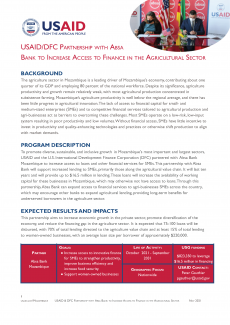BACKGROUND
The agriculture sector in Mozambique is a leading driver of Mozambique’s economy, contributing about one
quarter of its GDP and employing 80 percent of the national workforce. Despite its significance, agriculture
productivity and growth remain relatively weak, with most agricultural production concentrated in
subsistence farming. Mozambique’s agriculture productivity is well below the regional average, and there has
been little progress in agricultural innovation. The lack of access to financial capital for small- and
medium-sized enterprises (SMEs) and to competitive financial services tailored to agricultural production and
agri-businesses act as barriers to overcoming these challenges. Most SMEs operate on a low-risk, low-input
system resulting in poor productivity and low volumes. Without financial access, SMEs have little incentive to
invest in productivity and quality-enhancing technologies and practices or otherwise shift production to align
with market demands.
PROGRAM DESCRIPTION
To promote diverse, sustainable, and inclusive growth in Mozambique's most important and largest sectors,
USAID and the U.S. International Development Finance Corporation (DFC) partnered with Absa Bank
Mozambique to increase access to loans and other financial services for SMEs. This partnership with Absa
Bank will support increased lending to SMEs, primarily those along the agricultural value chain. It will last ten
years and will provide up to $16.5 million in lending. These loans will increase the availability of working
capital for these businesses in Mozambique, which may otherwise not have access to loans. Through this
partnership, Absa Bank can expand access to financial services to agri-businesses SMEs across the country,
which may encourage other banks to expand agricultural lending, providing long-term benefits for
underserved borrowers in the agriculture sector.
EXPECTED RESULTS AND IMPACTS
This partnership aims to increase economic growth in the private sector, promote diversification of the
economy, and reduce the financing gap in the agriculture sector. It is expected that 75-100 loans will be
disbursed, with 70% of total lending directed to the agriculture value chain and at least 15% of total lending
to women-owned businesses, with an average loan size per borrower of approximately $220,000.

